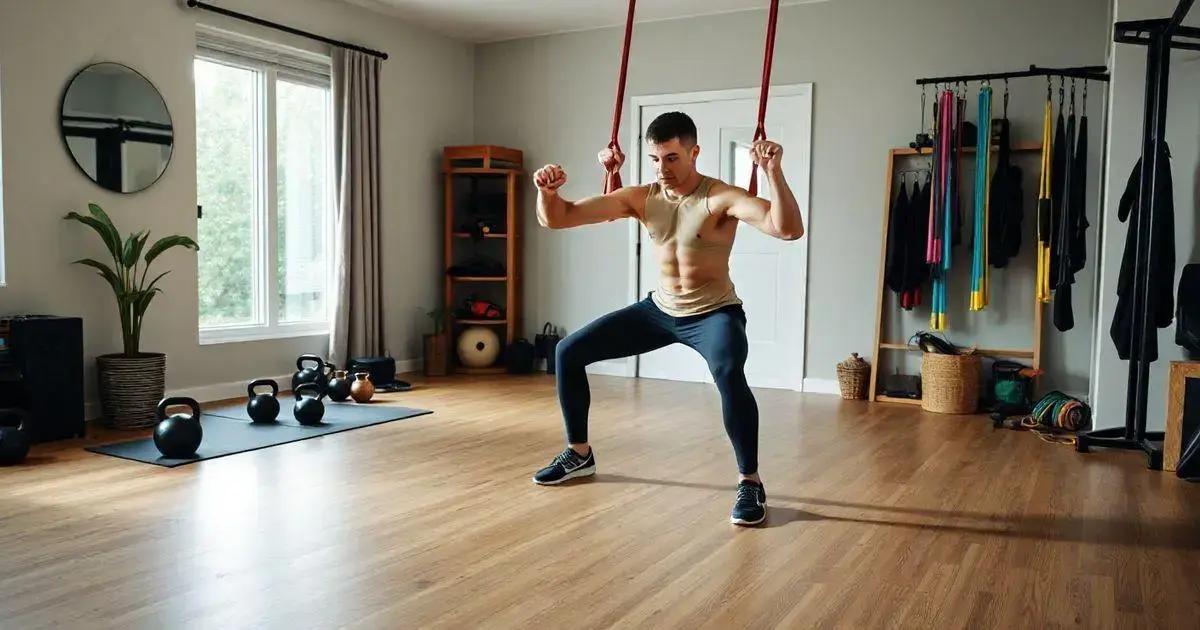Incorporating functional fitness exercises into your routine helps improve strength, flexibility, and endurance for daily activities. Start with a structured plan, stay consistent, and follow tips such as listening to your body and tracking progress for optimal results.
Are you looking to enhance your fitness journey? Adding functional fitness exercises to your routine can significantly improve your strength and flexibility for everyday activities. These exercises mimic real-life movements, making them applicable and beneficial in daily tasks. In this blog post, we will explore what functional fitness is, its benefits, and how to seamlessly incorporate it into your workout regimen.
Understanding Functional Fitness

Functional fitness refers to a style of exercise that enhances your ability to perform everyday activities. This type of training is important because it prepares your body for real-life movements, which helps you stay active, healthy, and injury-free. Rather than isolating specific muscle groups, functional fitness workouts mimic common movements such as bending, lifting, pushing, and pulling.
Key Principles of Functional Fitness
The foundation of functional fitness is built on three key principles:
- Multidimensional Movement: Engaging in exercises that reflect everyday movements. This includes pushing, pulling, squatting, and twisting.
- Core Stability: Strengthening your core is essential in functional fitness since a strong core helps support your spine and maintain proper posture during various activities.
- Balance and Coordination: Improving your balance and coordination can prevent falls and injuries, especially as you age.
Examples of Functional Fitness Exercises
Some common functional fitness exercises include:
- Squats: Great for enhancing leg strength and mobility.
- Lunges: Useful for developing balance and stability.
- Deadlifts: Effective for strengthening your back and core.
- Pushing Movements: Such as push-ups that enhance upper body strength.
When you incorporate these types of activities into your workout routine, you create a stronger foundation for everyday tasks. This means everyday activities like lifting grocery bags, climbing stairs, or playing with your children become easier and safer.
Benefits of Functional Fitness Exercises

Functional fitness exercises offer a range of benefits that go beyond traditional workouts. These exercises improve your overall health and enhance your ability to perform daily tasks with ease.
Enhanced Strength and Endurance
By engaging multiple muscle groups simultaneously, functional fitness strengthens your body. This training increases your overall endurance, allowing you to perform activities throughout the day without fatigue.
Improved Mobility and Flexibility
Functional fitness involves movements that require a wide range of motion. This training improves your flexibility and mobility, making it easier to bend, twist, and reach without stiffness or discomfort.
Better Balance and Stability
Many functional exercises challenge your balance, fostering better coordination and stability. This is particularly important for preventing falls and injuries, especially as you age.
Supports Healthy Weight Management
Incorporating functional fitness into your routine can help burn calories effectively. This workout style not only builds muscle but can also assist in maintaining a healthy weight while promoting a fit and active lifestyle.
Overall, the benefits of functional fitness exercises make them a smart choice for anyone looking to enhance their physical performance and daily functionality.
Incorporating Functional Fitness into Your Routine

Incorporating functional fitness into your routine can be simple and rewarding. Here are several effective strategies to consider:
Start with a Plan
Before diving into functional exercises, it’s essential to develop a fitness plan. Set realistic goals based on your current fitness level. This can include how many days a week you want to work out and which exercises you will focus on.
Choose Functional Exercises
Select a variety of exercises that engage different muscle groups. Include movements such as squats, lunges, push-ups, and kettlebell swings. These exercises not only improve strength but also mimic daily tasks.
Incorporate into Existing Workouts
You don’t need to overhaul your entire routine. Instead, add functional fitness exercises to your current workouts. For example, if you usually do strength training, incorporate functional moves into your warm-up or cooldown.
Utilize Equipment Wisely
Use tools like resistance bands, medicine balls, or stability balls. These can enhance your functional workouts and introduce variety. Ensure you learn proper techniques to maximize effectiveness and reduce injury risk.
Set a Consistent Schedule
Schedule your functional fitness sessions just like any other appointment. Consistency is key for developing new habits and reaping the benefits of your workouts. Aim for at least three times a week.
Track Your Progress
Keep a workout log to track improvements in strength, endurance, and flexibility. Monitoring your progress helps you stay motivated and adjust your routine as needed.
By following these steps, you can easily incorporate functional fitness into your routine and enjoy its many benefits.
Tips for Success with Functional Fitness

To achieve success with functional fitness, you can follow these important tips:
Start Slow and Progress Gradually
If you are new to functional fitness, begin with basic exercises. Focus on mastering form and technique before progressing to more complex movements. Gradually increasing intensity will help prevent injuries and build confidence.
Listen to Your Body
Pay attention to how your body feels during and after workouts. If you experience pain or discomfort, it is important to rest and assess your form. Modifying exercises can help you stay safe while benefiting from your workouts.
Stay Hydrated and Nourished
Proper nutrition and hydration are crucial for optimal performance. Drinking plenty of water before, during, and after workouts will keep your energy levels up. Incorporate a balanced diet rich in whole foods to support your fitness goals.
Prioritize Consistency
Set a regular workout schedule and stick to it. Consistency is key in developing your functional fitness skills. Aim to dedicate specific days each week for your functional training to make it a habit.
Find a Supportive Community
Joining a class or finding a workout buddy can greatly enhance your motivation. A supportive community provides accountability and encouragement as you embark on your functional fitness journey.
Track Your Progress
Keep a record of your workouts and improvements. Tracking not only helps you stay motivated but also allows you to see how far you’ve come. Celebrate small milestones as you advance in your functional fitness journey.
By following these tips, you can ensure a successful experience with functional fitness that will help you achieve your health and fitness goals.
Embracing Functional Fitness for a Healthier Life
By adding functional fitness exercises to your routine, you are taking a powerful step toward enhancing your overall health and physical ability. These exercises not only improve strength and flexibility but also help you perform daily activities with greater ease and efficiency.
Successfully incorporating functional fitness involves planning, consistency, and listening to your body. Remember the tips shared earlier, like starting slow, maintaining hydration, and tracking your progress to keep your motivation high.
With dedication and the right approach, functional fitness can significantly improve your quality of life, making you more agile, strong, and confident in your movements. So, take charge of your fitness journey and enjoy the numerous benefits of functional training.
FAQ – Frequently Asked Questions about Functional Fitness
What is functional fitness?
Functional fitness refers to exercises that help you perform everyday activities with ease, focusing on strength, flexibility, and balance.
What are the benefits of functional fitness exercises?
Functional fitness exercises improve strength, mobility, endurance, balance, and can aid in weight management, making everyday activities easier.
How do I incorporate functional fitness into my routine?
Start by creating a fitness plan, selecting functional exercises, and gradually integrating them into your existing workout schedule.
What tips can help me succeed with functional fitness?
To succeed, start slow, listen to your body, stay hydrated, maintain consistency, find a supportive community, and track your progress.
Can functional fitness workouts be done at home?
Yes, many functional fitness exercises can be performed at home using minimal equipment, making it a flexible training option.
How often should I do functional fitness training?
Aim to incorporate functional fitness exercises into your routine at least three times a week for optimal benefits.












